PinotFile: 7.7 December 17, 2008
|
Willamette Valley AppellationsOregon is known as the Beaver State, but it would be more apropos to label it the Pinot Noir State. I would even suggest that the Oregonians go one step further and name their state Noiregon. This is not a stretch, since Oregonians have a Pinot fixation that consumes them. Pinot Noir is by far the most widely planted grape in Oregon, totaling 9,858 acres out of a total of 17,400 acres (2007 data), second only to California in the United States. Pinot Noir accounts for 50% of total case sales, most of it crafted by small family owned producers who dot the rural landscape of the Willamette Valley. There has been an impression that Oregon’s winemaking community is primarily ex-hippies making Pinot Noir out of garages in their backyards. That might have had some validity back in the 1970s, but nothing could be further from the truth now. The newest generation of winemakers represent highly educated and talented masters of their craft working out of state-of-the-art wineries. By any measuring stick you choose, Oregon Pinot Noir is world-class. Perhaps the greatest vindication of the quality of Oregon Pinot Noir has come from the Burgundians who eagerly attend the yearly International Pinot Noir Celebration in McMinnville, Oregon, and the Steamboat Conference in southern Oregon which precedes it. Domaine Drouhin Oregon was Burgundy’s first committed interest in Oregon, but more are following, including respected vigneron Dominique Lafon, who became a consulting winemaker for Evening Land Vineyards this year. There are five major wine growing regions or appellations in Oregon. Oregon and Washington share the northern Columbia Gorge and Walla Walla appellations. The three western Oregon appellations are the Willamette Valley, the Umpqua Valley, and the most southerly Rogue/Applegate appellation. Some Pinot Noir is grown in selected microclimates in the Columbia Gorge, Umpqua Valley and Rogue appellations and show promising potential, but the Willamette Valley is Oregon’s heartland for Pinot Noir.
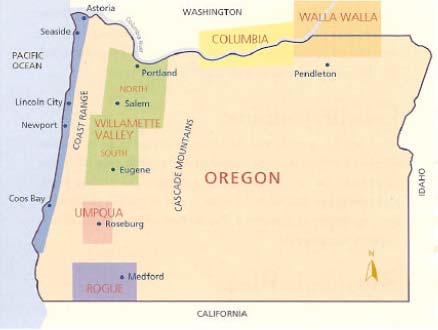 The Willamette Valley, so named for the river that runs through it, is 150 miles in length and 60 miles wide, extending over 3,438,000 acres from the Columbia River in Portland south through Salem to the Calapooya Mountains outside Eugene. The central Willamette Valley is situated at 45 degrees north latitude, the same as France’s Burgundy region. The Willamette Valley accounts for 75 percent of the total acreage and wine production in Oregon and is divided into a north and south portion, with the border located just below the state’s capital of Salem. The Willamette Valley is home to most of the over 370 wineries in Oregon and is ideal for growing Pinot Noir, with cool winters and warm, dry summers. Rain occurs almost entirely in the winter. There are more daylight hours during the growing season than any other region in the state. Most vineyards are on hillsides, from 200 to 800 feet above sea level, south or east facing, and situated west of the Willamette River. The hillside soils are ideal for growing grapes and consist of three types: basaltic soils which are composed of extrusive volcanic rock that is fine-grained and grey in color with loam and silt stained red by iron oxide (termed Jory soils); sedimentary soils formed by erosion of distant land masses and transported by water that are yellow to brown in color, typically loam over siltstone (termed Willakenzie soils); and loess soils which are deposits of silt laid down by wind action, fine-grained and light brown in color. Think fire, ocean and wind. Soil terminology can be very confusing. For the geology challenged, loam is soil composed of sand, silt and clay; silt is soil or rock of a grain size between sand and clay. The Oregonians have a singular obsession with soils and they will talk about it on end. It is part of their Pinot fixation. For the full story on the geologic history of the Willamette Valley, visit the Bethel Heights Vineyard website (www.bethelheights.com) and read the excerpt from Oregon Pinot Camp 2008 titled “Soil into Wine.” The deep alluvial soils (soil or sediment deposited by river water) on the valley floor possess high water holding capacity and are not conducive to grape growing. In addition, the threat of frost is always present at lower elevations, and some of the earliest attempts to grow grapes in Oregon failed because the vineyards were planted on the valley floor. The different soils contribute disparate flavors to the grapes grown in them. THIS IS THE KEY LESSON IN THIS ARTICLE! Willakenzie soil imparts more dark fruits, earthiness, chocolate, anise and spice with more structured tannins. Jory soil, in contrast, tends to produce wines that are redder fruited with sassafras, pomegranate and baking spices with good acidity and softer textures. These flavor profile generalizations are frequently difficult to clearly discover in Oregon Pinot Noir because of the many other variables involved such as vine age, clonal and rootstock material, vintage variation, and the winemaker’s hand. The winemaker in particular can play a significant role, challenging the taster to identify “land or hand?” Specific flavor profiles of the different appellations are often identifiable by the winemaker’s trained palate, but are considerably more challenging for the consumer to recognize. Within the large Willamette Valley appellation, which was approved in 1983, there are six smaller appellations located in the northern valley, each of which have distinctive microclimates, geography and soils. The six include Chehalem Mountains, Dundee Hills, Eola-Amity Hills, McMinnville, Ribbon Ridge, and Yamhill-Carlton District. The sub-appellations of the Willamette Valley were conceived primarily by California ex-patriot winegrowers who felt the Willamette Valley would benefit from an appellation system already successfully in place in California, by bringing more visible identity to the specific sub-regions of the Willamette Valley. Initially, several winegrowers in the valley did not receive the idea warmly, fearing that this scheme would fragment the region and dilute the prestigious Willamette Valley image. For the most part, this has not been the case. The locals admit that there is still a tremendous amount of information to be gathered and realize that it will take years to arrive at a definitive picture of each appellation. Winemaker Jesse Lange reflects the current opinion of many saying, “I believe whole heartedly that the AVA system for Oregon has just begun to blossom and will become more entrenched and respected as the vintages accrue. That’s where most of the fun is, aye?” The main underlying goal is to demonstrate differences among the appellations, without implying one appellation is superior to another. A topographical map of the Willamette Valley appellation and its six sub-appellations is on page 3 (courtesy of the Oregon Wine Board). Note the location of the Van Duzer corridor as this will be referenced several times in the following pages, particularly regarding the Eola-Amity Hills appellation. In the following pages, I have profiled each of the six Willamette Valley sub-appellations based on my review of appellation applications to the TTB and discussion with numerous winemakers in the Willamette Valley. In addition, extensive tasting notes gained during my recent visit to the Willamette Valley are provided from each sub-appellation. Finally, a Willamette Valley sub-appellation tasting with the Grape Radio gang will be presented. This will also be available in podcast format soon at www.graperadio.com.
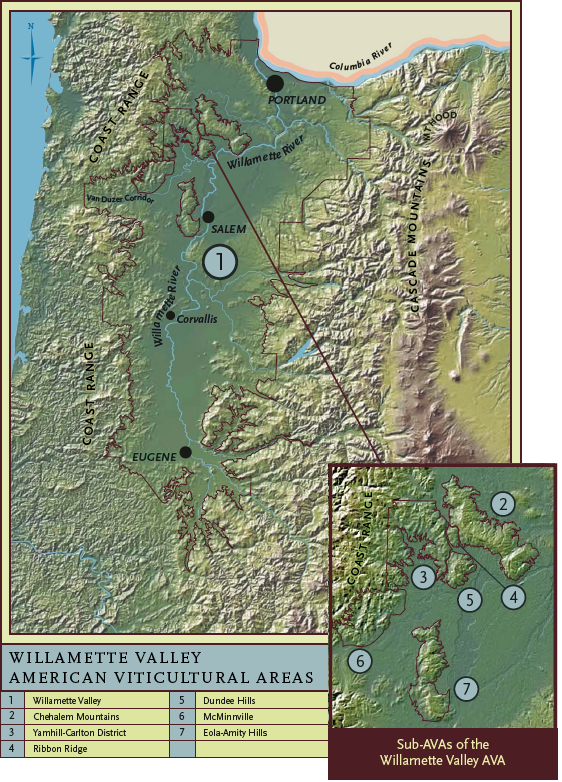
Chehalem MountainsAppellation Approval: 2006 History: Chehalem (Sha-HAY-lum) is from a Native American word Chahelim that was the name of a band of Native Americans who lived in this area. The name translates as “gentle place” or “place of flowers.” Dick Erath planted the first grape vineyards here in 1968 on a 49-acre property he bought in Yamhill County and named it Chehalem Mountain Vineyards. David Adelsheim, Dick Ponzi and others followed in the 1970s. The Chehalem Mountains Winegrowers is the appellation’s winery, vineyard and commercial association. Geography: Chehalem Mountains is located 19 miles southwest of Portland and 45 miles east of the Pacific Ocean. It is a single uplifted landmass with spurs, mountains and ridges. There are three sub-regions within the appellation including Parrot Mountain to the southwest, the northern and southern flanks in the middle and Ribbon Ridge at the southwestern tip. Ribbon Ridge is a separate appellation located entirely within the Chehalem Mountains appellation. Size: 20 miles long and 5 miles wide, totaling 68,265 acres. The highest mountains in the Willamette Valley are found here, with the tallest being Bald Peak at 1,633 feet above sea level. The appellation extends from 200 to 1,200 feet contour lines. Vineyards: 1,600 acres, over 120 growers and wineries. Wineries: 31 Soils: The Chehalem Mountains contain all three of the soil types found in the Willamette Valley. The northwestern flank is composed primarily of Laurelwood soil (loess), which is silty, nearly ashy, rock flour deposited on the mountains from powerful winds from the surrounding landscape during the last Ice Age, 0.5 to 1.5 million years ago. This soil is fine-grained and light brown in color. It is deposited primarily on top of basaltic (Jory) soil. On the southern flank and the southeastern tip known as Parrett Mountain, the geology is distinctly different. Here the primarily Jory soil was formed by lava flows from northeast Oregon known as the Columbia River Basalts 5 to 15 million years ago. The Missoula Floods later brought loam, gravel, rock and boulders to the area from Montana and Washington 10,000 to 15,000 years ago. The shallow topsoil overlies large polished stones and fractured basalt. In the western reaches of the Chehalem Mountains, in the Ribbon Ridge appellation, the soils are derived from ancient sea floor sediments that were uplifted and are yellow to ochre in color. Here the sedimentary soil is silty clay loam over siltstone and sandstone.
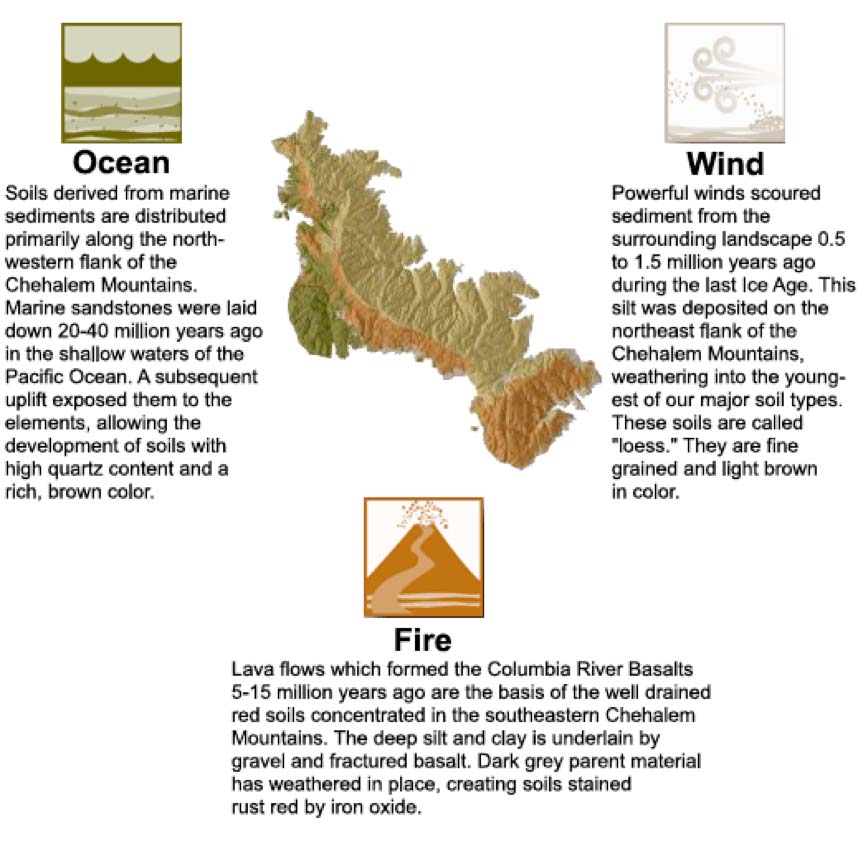 Climate: The Chehalem Mountains has significant annual precipitation. As the highest mountains in the Willamette Valley, the Chehalems create a large obstacle for west-to-east moving storms. When the moist air rises over the Chehalem Mountains, water vapor in the cooling air condenses and falls to earth as terraininduced rain. Annual rainfall ranges from 37 inches in the lower elevations to almost 60 inches at the highest elevation at Bald Peak. Temperatures vary more within the Chehalem Mountains than in any other region within the Willamette Valley. Flavor Profile of Pinot Noirs: This will vary depending on the sub-region of the appellation. In the northern reaches, plum, black pepper; in the southern flank prettier, more red fruited, roasted meat and nuts; in Parrot Mountain more minerality and bright red fruits; in Ribbon Ridge, bright red cherry that can be pushed to darker flavors with oak and extraction, roasted fruit. Prominent Producers in the Chehalem Mountains appellation: Adelsheim Vineyard, Allore Vineyards, Anam Cara Cellars, ArborBrook Vineyards, Artisanal, August Cellars, Barking Frog, Beran Vineyards, Bergström Wines, Blakeslee Vineyard Estate, Carabella Vineyard, Chehalem, Cooper Mountain Vineyards, Et Fille Wines, Freja Cellars, J. Albin Winery, J.K. Carriere, Lachini Vineyards, Laura Volkman Vineyard, Lawton Winery, Natalie’s Estate Winery, Owen Roe, Ponzi Vineyards, Privé Vineyard, Raptor Ridge Winery, Rex Hill Vineyards, Wild Air Cellars.

Shortly after the ¡Salud! Auction on November 11, 2008, I met with Sheila Nicholas, co-proprietor of Anam Cara Cellars, Dave Paige (photo left), winemaker at Adelsheim Vineyard, and Scott Schull, proprietor and winemaker at Raptor Ridge Winery to sample representative Pinot Noirs from the Chehalem Mountains appellation. This was quite an impressive lineup of Pinot Noirs and I thoroughly enjoyed the indulgence. The showy hedonism of the 2006 vintage in Oregon was in evidence. My tasting notes follow.
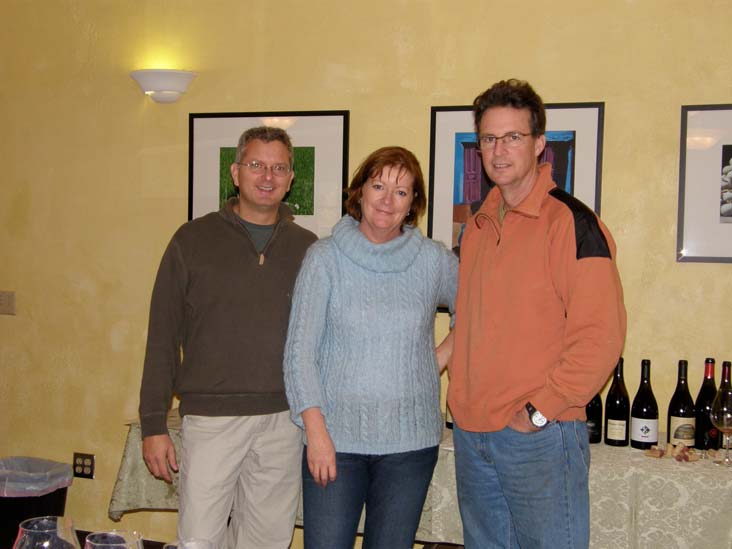
Parrett Mountain
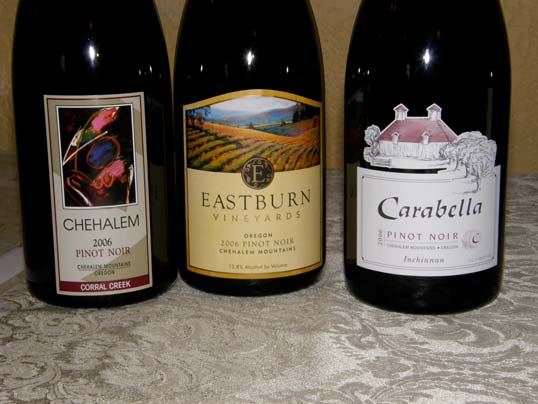
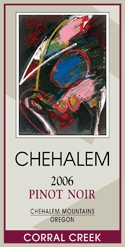 2006 Chehalem Corral Creek Vineyard Chehalem Mountains Pinot Noir 15.3% alc., 299 cases, $44. Corral Creek Vineyards surround the winery and were planted in 1983 by John and Diane Howieson, founders of Veritas Winery, from whom the vineyard was acquired in 1995. This 28- acre vineyard is predominantly planted to Pinot Noir. Soils are Laurelwood. Visible from Highway 99W, Corral Creek is a much photographed vineyard. Aged 11 months in 39% new French oak barrels. · Aromas of rose petals, red fruits, oak and loam lead to medium-weighted flavors of black cherries which are delicately spiced, oaked and tart. Nicely balanced and somewhat elegant with decent cherry aromas that offer some persistence on the finish.
2006 Eastburn Vineyards Chehalem Mountains Pinot Noir 13.8% alc., 450 cases, $38. The first vintage under this label. The 15-acre Eastburn vineyard is planted exclusively to Pinot Noir on an outcrop of red, volcanic Jory soil (rarely found outside of Dundee Hills). There are five acres each of Dijon clones 114, 115 and 777. Planted in 2001 and farmed to LIVE practices. · Well-endowed black raspberry and blackberry jam aromas and flavors with earthy accents. Attractive silkiness on the palate with well-integrated oak.
 2006 Carabella Vineyard Inchinnan Mountains Willamette Valley Pinot Noir 14.9% alc., 250 cases, $54. Carabella Vineyard is a 49-acre site on the southeastern side of Parrett Mountain. Winemaker Mike Hallock makes wines exclusively from Carabella Vineyard fruit. Soils are gravelly volcanic. This wine is crafted from clones 113, 115 and Wädenswil. · Some interesting minerality runs through this wine. Luscious black cherry flavor, nicely spiced, with exotic wood accents. A delicious wine with a silky and sensual presence that dances on the palate.
Chehalem Mountain
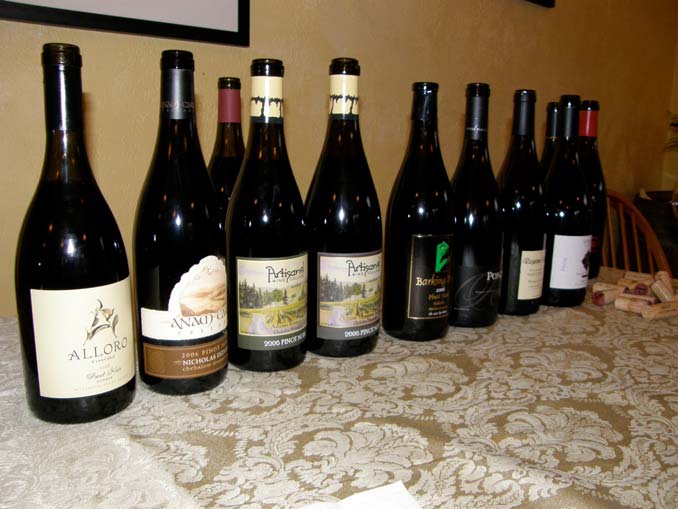
2006 Alloro Vineyard Estate Chehalem Mountains Pinot Noir 13.5% alc., $34. The 70-acre vineyard is situated on Laurel Ridge just north of Newberg at elevations of 375 to 700 feet. The soil is Laurelwood. Dijon and Pommard clones are farmed sustainably. David Nemarnik, founder and vineyard manager, established Alloro (Latin and Italian word for laurel) in 1999. A Mediterranean inspired winery and tasting room with underground cellars was completed in time for the 2003 harvest. This wine is a blend of four estate grown clones, aged in 27% new French oak, and is unfined and unfiltered. · Appealing scent of dark fruits, oak and spice cabinet. Ample ripe black cherry and black raspberry fruit is mouth filling and smoothly textured, and the finish is soft and smooth.
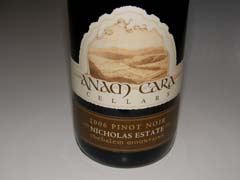 2006 Anam Cara Cellars Nicholas Estate Chehalem Mountains Pinot Noir 15.0% alc., 700 cases, $33. The words Anam Cara are Celtic for “friend of my soul” and symbolize the journey the owners, Sheila and Nick Nicholas have taken to make their wine. The winemaker is Aron Hess. Primarily Dijon 115 with added 667 and 777. Aged in 22% new, 15% once filled and 63% neutral French oak for 10 months. · Dark reddish-purple color. Sappy black cherry encased in oak vanillin and toast. Plush and generous, the wine retains a healthy elegance and the silky finish leaves a memorable impression.
2006 Artisanal Wine Cellars Adams Vineyard Chehalem Mountains Pinot Noir 14.5% alc., 286 cases, $28. This wine is composed of 25% self rooted Pommard planted in 1976, 25% self rooted Pommard planted in 1988, and 50% root stock 667 and 777 planted in 2002. Jory soils. Raised in 30% new French oak. Tom and Patricia Feller started Artisanal in 2005. Crafted at August West Cellars on Highway 99W between Sherwood and Newberg. · Bright and fresh red cherry and red berry scents. Light to medium bodied red fruited flavors with mild drying tannins. A decent, but not terribly exciting drink.
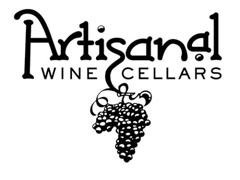 2006 Artisanal Wine Cellars Adams Vineyard Reserve Chehalem Mountains Pinot Noir 14.7% alc., 214 cses , $38. 80% self rooted Pommard planted in 1976, 10% self rooted Pommard planted in 1988, and 10% root stock 667 and 777 planted in 2002. Aged in 88% new French oak. A barrel selection. · This is clearly a step up from the regular bottling. Vibrant and long well-spiced cherry aromas. Powerfully flavored dark red fruits that are rich and succulent. Beautifully balanced with admirable integration of oak and alcohol. The silky finish goes on and on. Whoa, yeah, hell yeah!
2006 Barking Frog Blakeslee Estate Vineyard Chahalem Mountains Pinot Noir 105 cases, $36. Clones 115 and Pommard planted in Laurelwood soil. Aged 10 months in French oak. Crafted at August West Cellars. · This is a solid wine exhibiting richness with restraint. Plenty of lithe red fruit, spices, moderate ripe tannins and a refreshing finish with good acidic tang.
2007 Longplay Lia’s Vineyard Chehalem Mountains Pinot Noir 13.0% alc., 420 cases, $28. Inaugural release from the 25-acre Lia’s Vineyard which is composed of five Pinot Noir clones (115, 667, Pommard, Wädenswil and Mariafeld) planted in Jory soil from 1990 to 2002. Lia’s Vineyard was originally part of Rex Hill’s Jacob-Hart Vineyard. The older vines are own rooted. The vines are spaced at 5 x 9 with VSP trellising and are non-irrigated. This wine is 50% Dijon clones. The grower is Todd Hansen and winemaker is Aron Hess (formerly Rex Hill, now Daedalus Cellars and Anam Cara Cellars). · Light crimson in color. A demure wine that is red fruit driven with an appealing accent of oak spice and minerality. Picked at an average brix of 23 at harvest, this wine is understandably light in weight with a good acid spine. Will appeal to Pinot purists.
 2006 Ponzi Reserve Chehalem Mountains Pinot Noir 14.3% alc., 700 cases, $60. Produced from LIVE Sustainable vineyards planted primarily on Laurelwood soil. The blend is selected from Ponzi’s Madrona, Abetina and Aurora Vineyards as well as fruit sourced from Gemini, Linda Vista Vineyards and Lazy River Vineyards. 100% destemmed. Five day cold soak. Fermenters were aerated or manually punched down twice a day for 12-20 days. 7-day post-fermentation maceration. Aged in 50% new oak barrels for 20 months. Unfined and unfiltered and aged in bottle five months before release. · A regal wine with a lovely perfume that is both floral and intensely fruity. In the mouth, beautiful dark fruits are nicely spiced and adeptly framed by oak. Long, stylish and smooth with impeccable balance. Simply a great wine and an impressive followup to the incredible 2005 Ponzi Reserve.
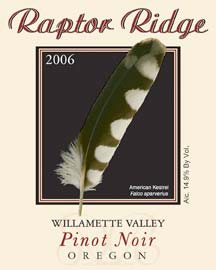 2006 Raptor Ridge Adalfo’s Block Raptor Ridge Estate Chehalem Mountains Pinot Noir 15.4% alc., $48.The 27-acre Raptor Ridge estate vineyard was planted to several clones in 2001 in deep Laurelwood soil. This wine represents the first harvest from the estate vineyard. · The palate of dark fruits is vigorous with flavor and character. The sappy blackberry liquor is long and tasty. A gentle touch of herbs and spice adds interest. The alcohol is well-integrated and the whole package is quite satisfying.
Ribbon Ridge
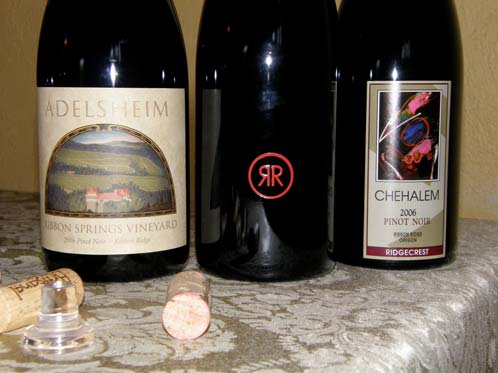
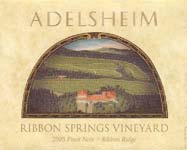 2006 Adelsheim Ribbon Springs Vineyard Chehalem Mountains Pinot Noir 13.9% alc., 299 cases, $58. Sedimentary sandstone based soils make up the Ribbon Springs Vineyard consisting of 80 acres of primarily Pinot Noir grapes. Pommard, Wädenswil and Dijon clones. The winemaker is Dave Paige. · The palate is all Pinot with mixed berry and black cherry fruit, uplifting acidity and supple tannins. Lovely texture and commendable balance. Gorgeous and pure.
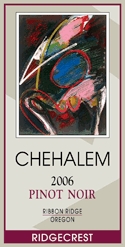 2006 Chehalem Ridgecrest Vineyards Chehalem Mountains Pinot Noir 15.2% alc., 587 cases, $44. Chehalem has had this bottling since its first release in 1990. Ridgecrest is a 55-acre vineyard on a 176-acre property. This site pioneered grape growing on Ribbon Ridge and dates to 1980. The soils are Willakenzie. Native yeast fermentation, 30% whole cluster, 6-10 days premaceration, aged 10 months, racking twice, with 50% new French oak barrels. · A powerhouse of a wine with intense aromas of crushed black cherries, spice, soy and roasted nuts. Mouth-coating with copious sweet, tangy black fruit that grabs a hold and persists on the finish. The racy acidity predicts a long life ahead.
 2006 RR (Ribbon Ridge) Ridgecrest Vineyards Chehalem Mountains Pinot Noir 14.9% alc., 594 cases, $69. This bottling represents the best wines sourced from the Ridgecrest Vineyards estate. Harry Peterson-Nedry, one of the founding partners of Chehalem, is the sole owner of this label. This wine is crafted in a masculine style in counterpart to the more feminine Chehalem Reserve sourced from this vineyard. · A powerful and charming nose of roasted black cherry fruit and nuts with a rose petal flourish. On the palate the fruit is thin and closed with plentiful acidity and notable oak on the finish. Right now this wine smells considerably better than it tastes and it needs more time in the bottle to unravel.
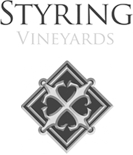 2006 Styring Vineyards Premier Estate Chehalem Mountains Pinot Noir 14.5% alc., 75 cases. · Interesting aromas of spiced berries and fennel seed. Raspberry flavors stand out with hints of anise. Well-crafted with a silky texture and fine-grained tannins. Delicious.
Also Tasted:
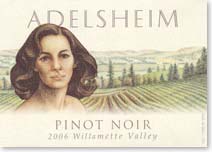 2006 Adelsheim Willamette Valley Pinot Noir 13.5% alc., 15,521 cases, $31. The flagship Pinot Noir from Adelsheim sourced from seven estate vineyards in the Chehalem Mountains and nine vineyards in other parts of the Willamette Valley. Both Jory and Willakenzie soil types are represented. 24% new French oak was used. · Cherries, spice and roasted nuts are quite flavorful in this wine which is light on its feet. Silky textured with refined acidity and a hint of earthiness on the finish. A perfectly fine entry wine.
Dundee HillsAppellation Approved: 2005 History: The Dundee Hills is the birthplace of Oregon Pinot Noir. It was here in 1966 that David Lett planted the first Pinot Noir in the Willamette Valley (The Eyrie Vineyard). A few years later, Dick Erath, the Sokol Blossers and others cleared south facing slopes in the Dundee Hills to plant many of Oregon’s first vineyards. Burgundy producer Maison Joseph Drouhin embraced the Dundee Hills as the next frontier in Burgundian varietals and bought 225 acres in 1987. The appellation’s byline has become, “The heart and soil of Oregon Pinot Noir.” The original name proposed for the appellation was “Red Hills,” but was subsequently changed to avoid possible confusion with other domestic and international “Red Hill” or “Red Hills” viticultural regions. The Dundee Hills Winegrowers Association (DHWA) was formed in March, 2006. The DHWA President is Jesse Lange of Lange Estate Winery. Geography: Located 28 miles southwest of Portland and 40 miles east of the Pacific Ocean. The Dundee Hills is an uplifted land mass in the center of the Willamette Valley, protected from extreme weather originating in the Columbia River Gorge to the north by the Chehalem Mountains and shielded to the west from Pacific Ocean rainstorms and winds by the Coastal Mountain Range. Dundee Hills is a north-south spine with ridges surrounded by small valleys on the east, south and west sides. The defining boundaries are Highway 240 to the north, Abbey Road to the west and Highway 99 to the south and east. The appellation elevation contours are from 200 to 1,067 feet above sea level. Size: 6,490 acres Vineyards: 2,000 acres, 50 vineyards. The Dundee Hills is the most densely populated sub-appellation in the Willamette Valley. Many vineyards are own rooted and quite old. The most prevalent clones in established vineyards are Pommard and Wädenswil, Oregon’s historical clones. Wineries: 32 Soils: Primarily volcanic Jory soils over sedimentary sandstone formed by ancient Columbia River basalt lava flows. The Jory series of reddish silt clay and loam is stained red with iron oxide (“Red Hills of Dundee”) and is the most defining and distinguishing feature of this appellation. 85% of the soil in the appellation is Jory series which is primarily found on the Dundee Hills eastern side. The soils typically extend 4 to 6 feet deep and show good drainage. The sedimentary Willakenzie soil series covers the steeper sloes of the Dundee Hills area’s western side.
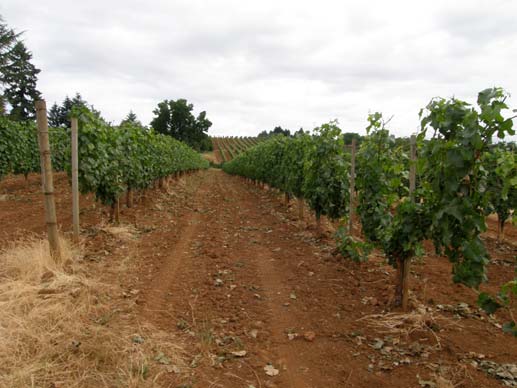 Climate: Because of its protected location, the Dundee Hills viticultural area is shielded from marked climatic variations. The nights are warmer, there is less risk of low-elevation fog and frost and the appellation is drier than the surrounding areas. The Dundee Hills receives about a third as much rain as the Coast Range (30-45 inches compared to 90-135 inches). Flavor Profile of Pinot Noirs: Nuanced, delicate, fruit-centric with good acidity and soft and silky textures. Red fruits (can be black depending on vintage) such as cherry and raspberry, pomegranate, sassafras, cola, Dr. Pepper, earth, baking spices, floral aromatics. Winemakers feel that wines from the Dundee Hills “jump out” and are distinctive enough to identify on a regular basis. Prominent Producers in the Appellation: Ana Vineyards, Anderson Family, Archery Summit, Argyle Winery, Arterberry, Ayoub Vineyard, Bella Vida Vineyard, Cottonwood Winery of Oregon, Daedalus Cellars, DePonte Cellars, Dobbes Family Estate, Domaine Drouhin Oregon, Domaine Serene, Duck Pond Cellars, Durant Vineyards at Red Ridge Farms, Dusky Goose, Erath Winery, The Eyrie Vineyards, The Four Graces, Lange Estate Winery and Vineyards, Le Cadeau Vineyard, Rambouillet Vineyard, Sokol Blosser Winery, Stoller Winery and Vineyards, Thistle Wines, Torii Mor Vineyard and Winery, Vista Hills Winery and Vineyard, Westrey Wine Co., White Rose Wines, Winderlea Vineyard & Winery, Wine Country Farm Cellars, Winter’s Hill Vineyard. (Note, some producers have a Dundee Hills vineyard but the winery is at another location.)

On Monday, November 10, I met with Sheila Nicholas, owner of Anam Cara Cellars, Jesse Lange, proprietor and winemaker of Lange Estate Winery, and Joe Dobbes, proprietor and winemaker of Dobbes Family Estate. At the Dundee Bistro, we tasted through a representative series of 2006 Dundee Hills Pinot Noirs. The 2006 vintage was warm and the fruit in these wines shows great ripeness, while retaining adequate acidity. The 2006 vintage had the third highest heat units since 1983. Although the Dundee Hills Pinot Noirs are known for redder fruit profiles, the warm 2006 vintage produced some wines with darker fruit profiles. After tasting these wines and the Chehalem Mountains wines the next day, I felt more confident in understanding the aromatic and flavor differences apparent in the wines from the two appellations.
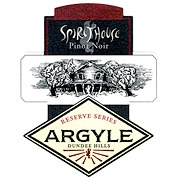 2006 Argyle Spirithouse Dundee Hills Pinot Noir 14.5% alc., 1,360 cases, $85. This bottling from the Knudsen Vineyard in the Dundee Hills is Argyle’s top-of-the-line Pinot Noir. The winemaker is Rollin Soles. · Great core of dusty cherry fruit with notes of spice and roses and the right touch of acidity on the tangy finish. Plenty of structure to last. The silky texture is memorable.
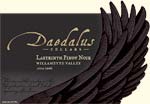 2006 Daedalus Cellars Labyrinth Willamette Valley Pinot Noir 620 cases, $45. 32% Dundee Hills fruit (Maresh Vineyard, Murto Vineyard), 24% Chehalem Mountains fruit (Carabella Vineyard), and 44% Eola-Amity Hills fruit (Seven Springs Vineyard). Pommard (mostly), Wädenswil, and 114 clones. 7-32 day cold soak, 15% whole cluster fermentation, total skin contact 17 to 42 days, aged 14 months in French oak 28% new, 32% second fill and 40% neutral. Unfined and unfiltered. · A darker fruit driven wine with layered flavors and appealing floral aromas. Nicely balanced with perfect integration of oak.
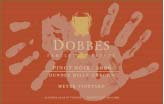 2006 Dobbes Family Estate Meyer Vineyard Willamette Valley Pinot Noir 14.4% alc., 174 cases, $65. 100% Meyer Vineyard fruit. Laurelwood soil. 70% whole cluster fermentation. 6 day cold soak, indigenous fermentation, aged 11 months in 50/50 new to neutral French oak, racked twice before bottling. · A very elegant wine showing off attractive bright red cherry, pomegranate and spice complimented by earth and hay. An engaging and harmonious Pinot with supple tannins, a seductively silky mouth feel and vibrant acidity.
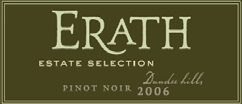 2006 Erath Estate Selection Dundee Hills Pinot Noir 13.5% alc., $36. A blend of the best wines from several sites, mostly Knight’s Gambit Vineyard. Aged 15 months in 40% new French oak. The winemaker is Gary Horner. · Super ripe chewy dark fruit with a hint of raisin, cinnamon and oak. Plush mouth feel with prominent ripe, sweet tannins.
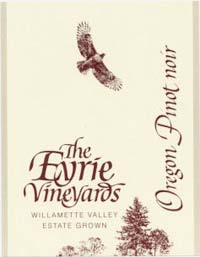 2006 The Eyrie Vineyards Estate Dundee Hills Pinot Noir 1,670 cases, $33. Yields of 2.2 tons per acre of fully ripened fruit. This is the estate’s “young vine” cuvée, with vines averaging 20 years in 2006. Aged in mostly neutral French oak for nearly two years. · A bit austere and quite elegant typical of the Eyrie style. Tart red cherry and cranberry flavors accented by herbs and stem spice with distinctive aromas of wildflowers. Better matched with food than sipped alone.
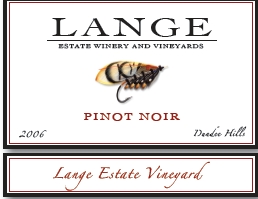 2006 Lange Estate Winery and Vineyards Lange Estate Vineyard Dundee Hills Pinot Noir 13.9% alc., 285 cases, $60. Yields were 2 tons per acre. Aged 13 months in 40% new French oak. · Bright red cherry and rose petal aromas. Juicy and succulent red cherry and raspberry fruit coat the mouth with hints of dust and Xmas spice and ending in a long, scented finish. The whole package is impressively harmonious.
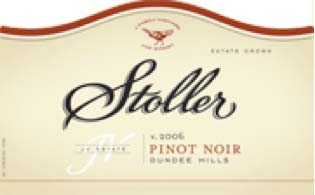 2006 Stoller Vineyards JV Estate Dundee Hills Pinot Noir 14.5% alc., 3,035 cases, $28, screw cap. Younger high density plantings. Clones 115, 667, 777, Pommard, and Wädenswil. De-stemmed into steel fermentation tanks, 7-10 days cold soak, 50/50 native/commercial yeast fermentation, aged 10 months in 35% new and 65% neutral French oak. · This wine is a strawberry rocket with plentiful strawberry notes prominent among the melange of berries featured in the aromas and flavors. The nose offers oak vanillin and caramel as well. Really tasty with enough mid-palate richness to stand up to substantial food. Nicely balanced with a short, but tangy finish.
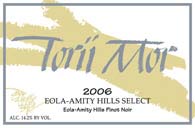 2006 Torii Mor Dundee Hills Select Pinot Noir 14.33% alc., 409 cases, $52. La Colina, Bella Vida, and Estate vineyards. Aged 13 months in 23% new, 26% one year old and 23% two year old French oak barrels. Racked twice. Jacques Tardy is the winemaker. · Dusty red cherries, raspberries and pomegranates with prominent baking spices. Clean, smooth, elegant and stylish. A wine lover’s Pinot.
 2006 White Rose Dragon’s Bluff White Rose Vineyard Dundee Hills Pinot Noir 13.9% alc.,198 cases, $75. This wine is produced only in exceptional vintages. The White Rose Vineyard was planted in 1980 on east facing Jory soils at 750-900 feet (one of the highest in the Dundee Hills). The wine represents a selection of the best barrels from the vineyard. Aged 15 months in French oak barrels. · Tremendous aromas of red cherries, Asian spice and warm cookies. Sweet red fruit fills the mid palate with touches of sassafras and oak. Nicely composed and very approachable now, although the core of flavors will be more expressive with a couple of years in the cellar.
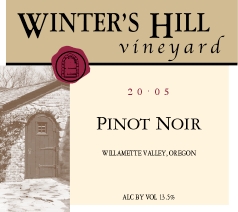 2006 Winter’s Hill Vineyard Dundee Hills Pinot Noir 14.1% alc., 1,195 cases, $29. From 21 acres of Pinot Noir planted between 1990 and 2000, primarily Pommard, Dijon 114 and 115, with some Wädenswil. The vineyard is south facing at an elevation of 525 to 730 feet. 100% de-stemmed, 2 day cold soak, fermented in one-ton fermenters using inoculated yeast, and aged in 25% new oak (French and American). · Very ripe dark cherry flavor profile with a hint of musk, pepper and spice. Lush and tasty on the palate with a lively finish.
Eola-Amity HillsAppellation Approved: 2006 History: The first plantings date to the early 1970s. Amity Vineyards was founded by Myron Redford in 1976. The Casteel family along with Pat and Barbara Dudley and Marilyn Webb arrived in 1977 and opened Bethel Heights Winery in 1984. Evesham Wood and Witness Tree settled in the Eola Hills in the late 1980s. Cristom Vineyards founder Paul Gerrie was searching for vineyard property in 1991 with the assistance of Beaux Freres winemaker Mike Etzel. He found a neglected vineyard in the Eola Hills owned by a winery called Pellier, managed by a member of the family operating Mirassou Vineyards. In 1992, Gerrie bought the property and created Cristom Vineyards. Geography: The Eola-Amity Hills appellation is located in the center of the Willamette Valley, half way between Portland and Eugene and south of the other five sub-appellations. The Eola Hills straddles the 45th parallel on the southern end and the Amity Hills make up the northern spur. The main ridge has a seahorse contour, running north to south with many lateral ridges, primarily at elevations of 250 to 700 feet above sea level. The most prominent geographic feature is the Van Duzer corridor directly to the west, which is the largest gap in the coastal range of mountains. The west side is more exposed and the coolest, while the east facing slopes are warmer. The largest concentration of vineyards is in the middle of the hills, providing protection from the marine incursion from the west. The wines of Eola-Amity Hills are different depending on the geographic site of the vineyard source within the appellation. Size: 37,900 acres Vineyards: 1.460 vineyard acres Wineries: 30 Soils: Primarily volcanic basalt Jory series soils secondary to lava flows. The predominant type of Jory soil is Nekia, a volcanic, sandy clay loam, shallower than the deep Jory soils found in the Dundee Hills, and located primarily on the hillside uplands. Marine sedimentary rocks and alluvial deposits are found at lower elevations. Climate: The Van Duzer corridor significantly affects weather in the Eola-Amity Hills. The daytime highs are about the same as appellations to the North, but the evenings are cooler due to a mid-afternoon ocean breeze. Commonly, the evening temperatures drop into the 50s even in summer. Flavor Profile of Pinot Noirs: The fruit tends towards blackberry, black cherry and plum with a minerality evident on the nose and the palate. The wines tend to be full-bodied and favor primary fruit character over spice. Compared to the other North Willamette Valley regions, the wines have brighter acidity and firmer structure, along with longevity. Wines from lower elevations tend toward plum with secondary flavors of earth, herbs and dried flowers. In hot vintages, the wines are more balanced, while in cool vintages ripeness and yields can be an issue. Prominent Producers in the Appellation: Antica Terra Vineyard, Amity Vineyards, Bethel Heights Vineyard, Bryn Mawr Vineyards, Cherry Hill Winery, Cristom Vineyards, Cubanismo Vineyards, Dukes Family Vineyard, Evasham Wood Vineyard & Winery, Kristin Hill Winery, Mia Sonatina Cellars, Mystic Wines, St. Innocent Winery, Strangeland Vineyards & Winery, Toluca Lane, and Witness Tree Vineyard. Appellation Website: None

While visiting Oregon in November, I stopped in at Bethel Heights Vineyard and tasted
through the entire lineup of Bethel Heights Pinot Noirs from the 2006 and 2007 vintage.
Mimi Casteel, who grew up at Bethel Heights and one of the second generation of Casteels
who have gradually assumed management of the property, guided me through the tasting.

I also interviewed Ted Casteel, one of the original founders of the winery and vineyard
manager for Bethel Heights. His brief, but informative, discussion of the Eola-Amity Hills
appellation will be presented on a future Grape Radio program.
Bethel Heights was founded in 1977 and was one of the first vineyards planted in the Eola Hills northwest of Salem. The 70-acre estate vineyards and winery have been owned and operated by the Casteel family and partners Pat and Barbara Dudley and Marilyn Webb since the beginning. Ted Casteel looked after the vineyards and Terry Casteel made the wine for the first thirty years. Pat Dudley and Marilyn Webb oversee marketing and the business side of the winery. Over the years, Bethel Heights has earned a much-deserved reputation for small lots of distinctive block-designated reserve Pinot Noirs and rich, balanced Chardonnays. The beautiful tasting room with its terrace and picnic area commands a panoramic view (photo below) of the surrounding vineyards, the valley below and Mount Jefferson in the distance. The current production of 13,000 cases includes Pinot Gris and Pinot Blanc, Chardonnay and Pinot Noir. Winemaking duties are gradually being assumed by Terry Casteel’s son, Ben.
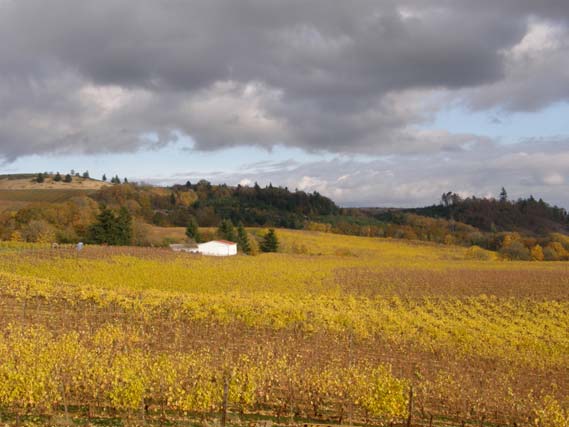 Most of the wine production comes from own rooted Pinot Noir vines planted over 30 years ago. In 1999, the 20-acre Justice Vineyard was planted adjacent Bethel Heights as part of the estate. Seventy-five percent of the plantings are Pinot Noir. The original 50-acre Estate Vineyard is planted on a south facing hillside at 480-620 feet elevation, with shallow well-drained Jory/Nekia soil series. The Justice Vineyard sits lower on the hillside and shows transitional soils between volcanic layers above and marine sedimentary layers below. Ted Casteel pioneered the development of standards for sustainable viticulture in Oregon and Bethel Heights was one of the first wineries certified LIVE and Salmon Safe. The 2006 Bethel Heights Pinot Noirs were darkly colored, generous in alcohol, stacked and packed with fruit and very sexy. Think actress Julianne Moore in leopard print flaunting her hair and cheek bones. The 2007 wines (several of which were just bottled) were more restrained and nuanced and showed more pinotosity. More jene sais quoi of the French style like actress Juliette Binoche. 2007 was a more challenging vintage as picking had to be done around the rains at harvest. Mimi told me the difference between the 2006 wines and those from the similarly hot 2003 vintage is that the 2006 Pinot Noirs have better acidity and my tasting confirmed that. The Bethel Heights Pinot Noirs have consistently fine spiced fruit aromatics and you don’t think oak when you taste the wines. Mimi told me one of the hallmarks of Bethel Heights Pinot Noirs was flavors of “Coca-Cola and blackberries.”
2006 Bethel Heights Jesse James Vineyard Eola-Amity Hills Pinot Noir 14.8% alc., 143 cases, $50. The first bottling from an extremely well-tended non-estate 4-acre vineyard planted to Pommard, Wädenswil and Dijon 667. The grapes were sourced for blending but stood out so well they were designated. 1.5-ton fermenters were layered with 20% whole clusters and the remainder of the fruit was de-stemmed and placed on top of the whole bunches and left to cold soak for 5 days. Punched down twice a day during the 14 day fermentation. Aged 15 months in 50% new French oak barrels. · A generous wine showing beautiful dark cherry, raspberry and plum fruit with ample acidity and noticeable but not imposing tannins.
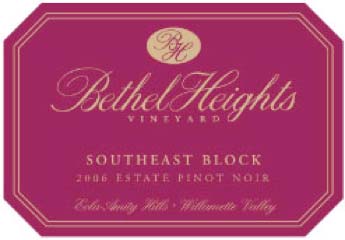 2006 Bethel Heights Southeast Block Eola-Amity Hills Pinot Noir 14.9% alc., 141 cases, $50. From a 6- section of the estate vineyard planted in 1979. 100% Pommard clone planted on their own roots, trained to a Scott Henry trellis and cropped to two tons per acre. 20% whole cluster fermentation. A barrel selection blended for this reserve wine. · A killer on the palate with massive black raspberry fruit. Muscular but retaining a stylish focus and a creamy texture that is most appealing. Showing just a delicate kiss of wood and gossamer tannins.
2006 Bethel Heights Justice Vineyard Eola-Amity Hills Pinot Noir 14.2% alc., 250 cases, $50. 17 acres planted between 1999 and 2001. Clones 667 and Pommard were selected for a separate bottling. Made up of wine from two fermenters with 50% and 100% whole clusters. 5 day cold soak, racked twice, aged 16 months in 50% new French oak barrels. · Lighter in weight and the most demure wine in the lineup. Pleasing ripe berry and cherry fruits attractively spiced with supple tannins and lively acidity on the refreshing finish.
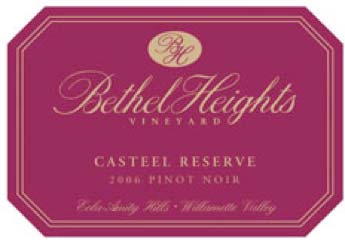 2006 Bethel Heights Casteel Reserve Eola-Amity Hills Pinot Noir 14.8% alc., 747 cases, $60. 48% Bethel Heights Wädenswil block, 17% Bethel Heights clone 114, 10% Bethel Heights clone 777, and 25% Seven Springs Vineyard (last call!). 25% whole cluster, 5 day cold soak, both native and cultured yeast fermentation, racked once. Barrel aged 13 months in 50% new French oak. Unfiltered. · Dark red fruits and oak spice dominate the substantial aromas and flavors. The perky acidity and slippery tannins make the wine easy to drink and the long, long finish leaves a pleasant impression.
2006 Bethel Heights West Block Eola-Amity Hills Pinot Noir 15.2% alc., 141 cases, $50. Composed of Wädenswil clones (UCD 1A) planted in 1977 on their own roots in a 5 acre section of the estate vineyard. These are the oldest Pinot Noir vines at Bethel Heights. In the warmest vintages like 2006, the late harvest allows the Wädenswil clone to achieve maximum flavor development and a few select barrels are chosen for a block-designated wine. Gently de-stemmed and cold soaked for 5 days, then inoculated with proprietary Burgundian yeast, aged 16 months in 50% new French oak barrels. · This is a prodigious wine with massive concentration but is not jammy as there is plenty of acid to balance the fruit. Noticeable oak compliments the spiced and syrupy dark cherry and raspberry fruit leading to a lively citric tang on the finish. The alcohol is held in tow by the impressive balance.
2007 Bethel Heights Eola-Amity Hills Cuvée Pinot Noir 13.2% alc., 1.612 cases, $30. From estate and five sourced vineyards in the appellation. Aged 10 months in 35% new French oak barrels. · Well-spiced cherry and berry fruit with overtones of brown sugar with a sensible grip. A bit of alcohol peaks out on the nose.
2007 Bethel Heights Estate Eola-Amity Hills Pinot Noir 13.2% alc.. · Tart cherry and cranberry flavors form the nucleus of this medium-weighted wine featuring lovely floral and herbal notes on the nose and soft tannins on the finish.
2007 Bethel Heights Casteel Reserve Eola-Amity Hills Pinot Noir 13.2% alc.. · Alluring scents of fresh berries, minerals and savory herbs. The fruit is juicy, sweet and subtlety spiced. The perky acidity on the finish makes you want another sip.
2007 Bethel Heights Justice Vineyard Eola-Amity Hills Pinot Noir 13.2% alc.. Primarily Dijon clones 114, 667, 777. · An impressive expression of redder fruits enhanced by Asian spices backed by a bright acidic backbone. A lovely wine of charming elegance.
2007 Bethel Heights Flat Block Eola-Amity Hills Pinot Noir 13.2% alc.. The Flat Block is a 3.3 acre section of the estate vineyard planted in 1979 all to Pommard clone. The rocks underlying this block have a different mineral composition from those of the Southeast Block. As a result, this wine is the most refined and elegant of the Bethel Heights Pinot Noirs. · When I tasted this one I wrote, “Gorgeous” and underlined it. This is classic Pinot Noir with perky dark red Pinot fruits livened with herbs and spice and set off by brisk acidity and supple tannins. This could be the star of the vintage.
2007 Bethel Heights Southeast Block Eola-Amity Hills Pinot Noir 13.2% alc.. The grapes from this block were the last to be picked in this vintage. · This is a highly structured and textured wine with tannin to spare. There are copious amounts of black cherry and black raspberry fruit framed by healthy oak, earth and meat. Don’t even think about drinking this wine for another year or two.
Bethel Heights is located at 6060 Bethel Heights Road, NW about twenty minutes northwest of Salem and thirty minutes southeast of McMinnville. The tasting room is open from May to October, Tuesday thru Sunday from 11:00 to 5:00 and other times by appointment. Visit the informative website at www.bethelheights.com. The phone is 503-581-2262. Most of the 2006 Pinot Noirs are still available. The Bethel Heights Eola-Amity hills Cuvée is the only 2007 Pinot Noir released as of November, 2008. This is a long-established outstanding producer of Oregon Pinot Noir that I can recommend without reservations.
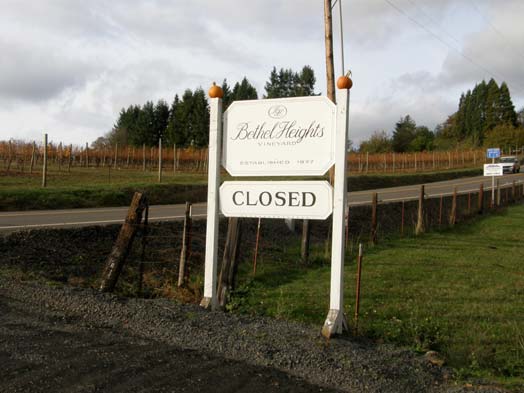
McMinnvilleAppellation Approved: 2005 History: David Lett’s first winery for The Eyrie Vineyard was in McMinnville and now there are many wineries in the so-called Urban Pinot Quarter of downtown McMinnville. Geography: The region is a 2000-foot thick bedrock formation extending west from the city of McMinnville and south-southwest toward the mouth of the Van Duzer corridor. This appellation is largely defined by elevation, with contours extending from 200 to 800 feet above sea level. Areas below 200 feet have greater depth of soils causing delayed ripening and greater risk of frost. Above 800 feet there are fewer degree-days available to ripen grapes. The vineyards are primarily south and east facing. Size: 40,500 acres Vineyards: 600 acres Wineries: 14 Soils: The region is quite different in soil profile from other wine growing areas in Yamhill County. The soils are primarily marine sedimentary loams and silts (Willakenzie) with alluvial overlays. Clay and silt loams average 20-60 inches before reaching underlying basalt rocks and stone. In most cases the soils are well drained. The ground water has more sodium, potassium and boron compared to the region to the East and these minerals contribute to the uniqueness of the wines. Climate: The appellation is in the protected weather shadow of the Coast Range Mountains so there is less rainfall (33 inches annually) compared to Eola-Amity Hills (40 inches annually) which is only twelve miles to the southeast. The result is less botrytis pressure. The southern portion is exposed to cool and drying winds through the Van Duzer corridor and this further reduces disease issues. Flavor Profile of Pinot Noirs: The wines have plenty of color with a strong backbone of tannin and acidity. Intense black fruit, earth, wet leaf and spice are typical. Prominent Producers in the Appellation: Brittan Vineyards, Coleman Vineyard, Coeur de Terre Vineyard, Maysara Winery-Momtazi Vineyard, Seufert Winery, Stony Mountain Vineyard, Yamhill Valley Vineyards, and Youngberg Hill Vineyards. Appellation Website: www.mcminnville.org.
I spent some time in Oregon getting to know Moe and Flora Momtazi and their remarkable story should be briefly detailed here. The Momtazis are Iranian expatriates who fled the country in 1982 a few years after the Iranian hostage crises. Flora was eight months pregnant when Moe had her hop on the back of his motorcycle and together they perilously escaped to Pakistan. Little did they know then that their daughter would become their winemaker many years later. They made their way to Texas where Moe had studied civil engineering after high school. Their final destination was Oregon, attracted by the farming lifestyle. Moe had been heavily influenced by his grandfather who farmed sustainably in Northern Iran and his father who made his own wine. In 1997, the couple bought 532 acres of abandoned wheat farm just south of their home in McMinnville. The neglected land had been free of chemicals for seven years. They spent considerable time and effort in reclaiming the land and eliminating unwanted plants and weeds. Although chemicals would have made the process much quicker and more economical, not a single one has been or will ever be used on the property. Planting started in 1998 with three blocks of self-rooted Pommard clone Pinot Noir, 13 acres total. In 1999 a nursery was established and over 120,000 plants were grafted in the greenhouses and planted that year. Photos of the nursery are below.
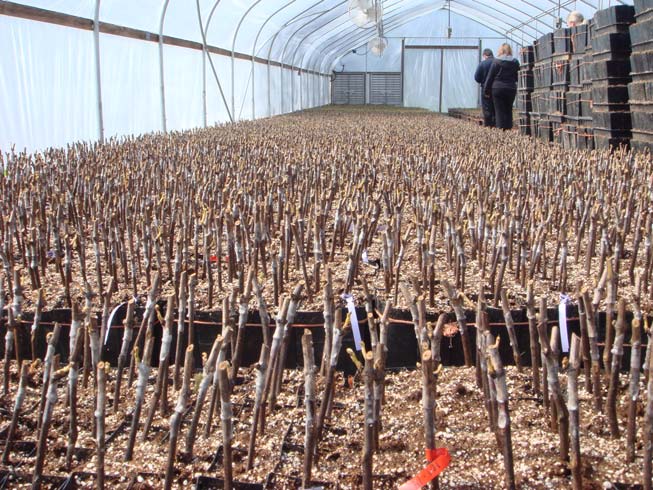
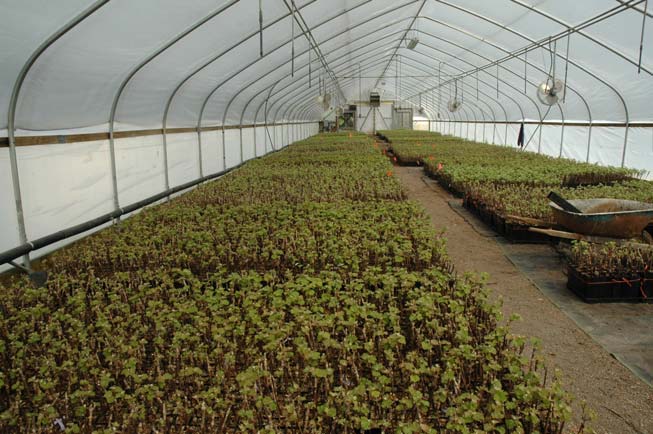 Considerable research was spent on matching different varieties and clones to the different soil types found in the vineyard. The property has highly diversified soil types consisting primarily of Nekia and Willakenzie series with veins of Jory. Today, there are over 225 acres of vines with plans to plant another 30 acres in the spring. Enjoy these beautiful photos of the Momtazi Vineyard.
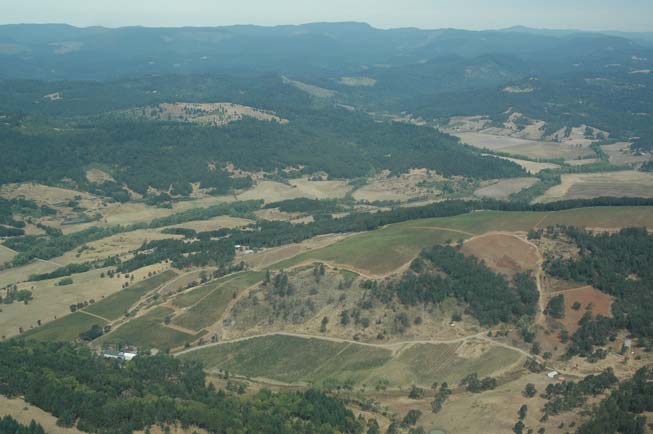
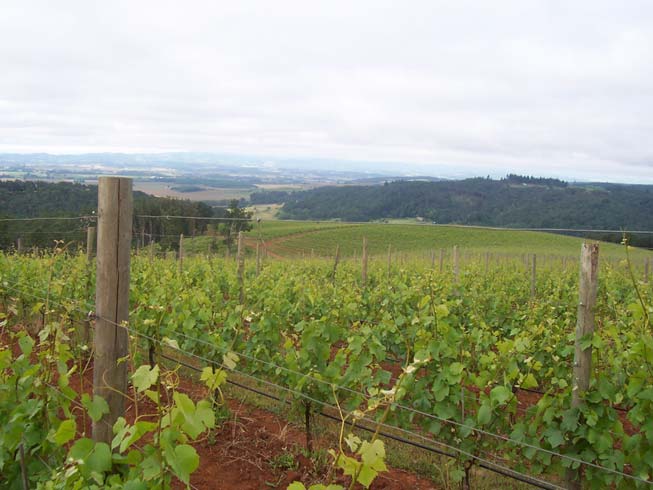
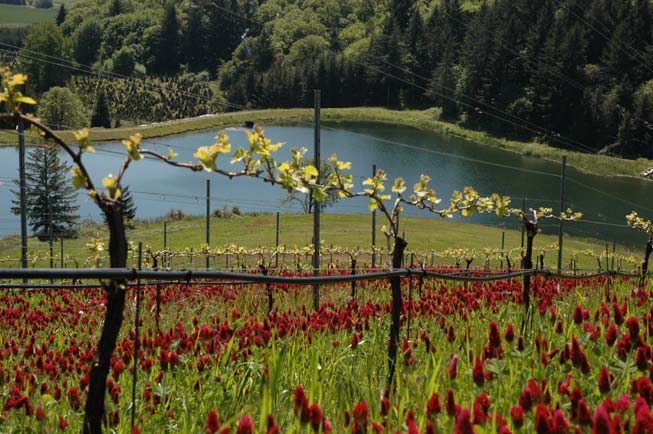
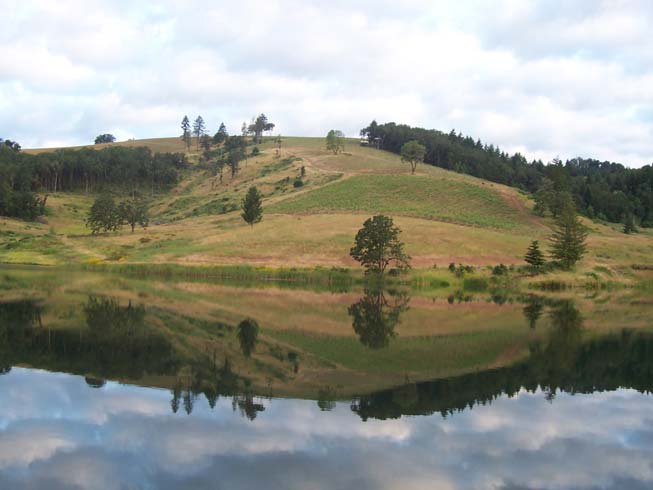
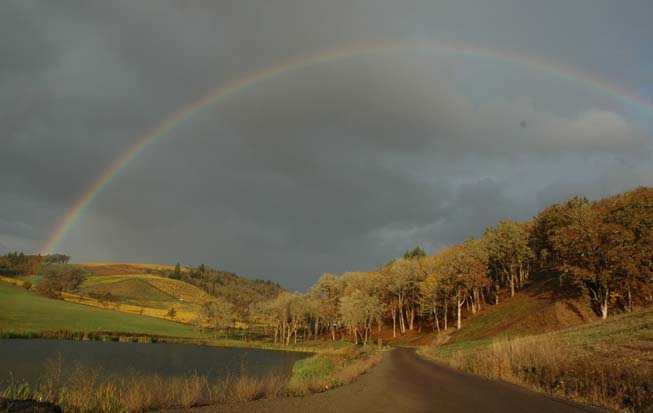
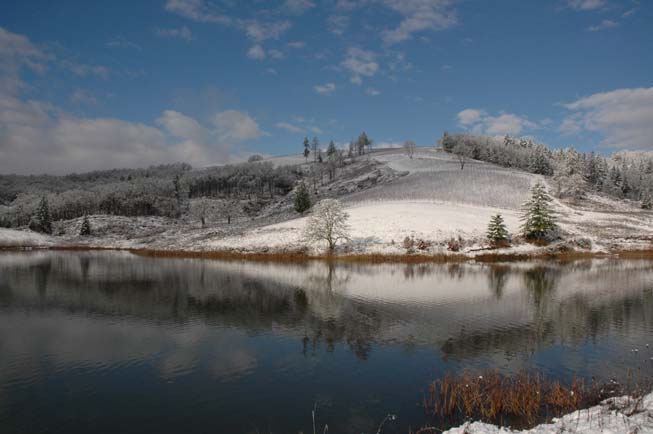
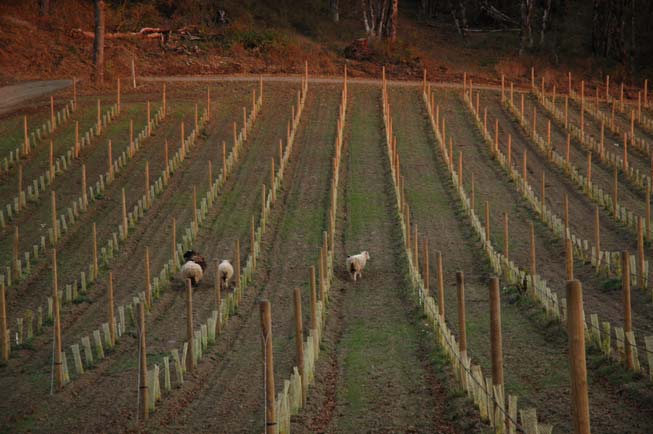 At the start, the Momtazis practiced organic farming using the natural methods Moe had learned from his grandfather. The search for even more natural alternatives led them to biodynamic farming. Today, Momtazi Vineyard is the largest Demeter Certified Biodynamic® vineyard in Oregon. A variety of plants and herbs are grown to make into compost teas to harness their beneficial properties. Compost and biodynamic preparations are extremely important to the Momtazi vineyards. There are multiple compost piles and the resulting humus is worked into the vineyards and potential vineyard sites throughout the farm. The ultimate goal is long-term earth and vine health. Pictured below are the apparatus for making compost tea, the compost itself, and the cow’s horn (one of the biodynamic preparations) before burial in the vineyard.
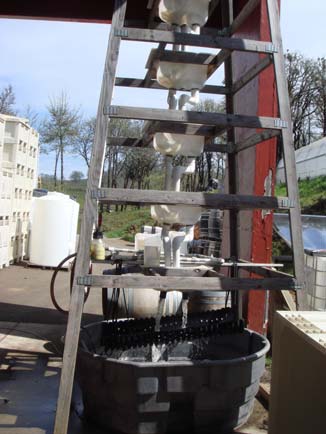 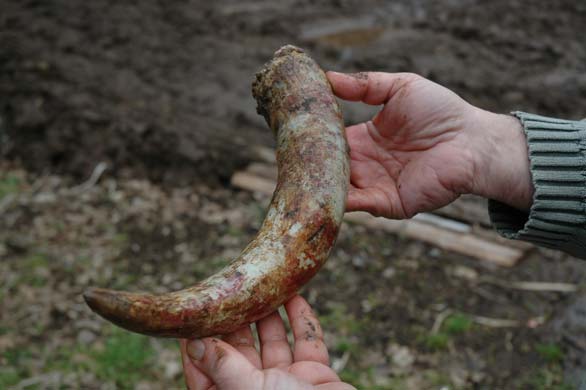
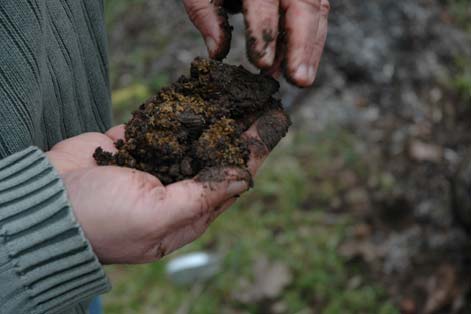 In 2001, an 8-acre reservoir, the first and largest of the two on the property, was completed. It is fed by natural springs and run-off and provides a source of irrigation water and a home for rainbow trout. Rainbow trout require the purest water, and since the reservoirs sit at the lowest points on the property, their thriving population is a testament to the Momtazi’s farming methods (see Moe below with a prize catch).
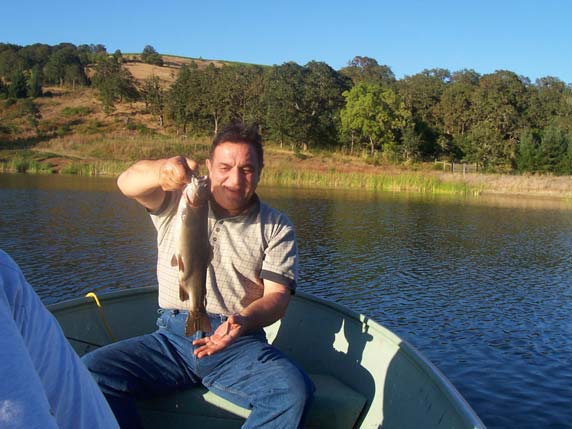 The Maysara winery is located on the Momtazi estate. Maysara is a Persian word meaning “house of wine” (sara translates as house and may as wine). Tahmiene Momtazi, the eldest daughter, earned a BS in fermentation science with a minor in chemistry at Oregon State University and worked at Maysara since the first vintage in 2001. She gained valuable experience at other wineries as well including Belle Valle in Corvallis, Kim Crawford in the Marlborough region of New Zealand and Toluca Lane in Newberg. She has been in charge of winemaking at Maysara since 2007. I tasted Maysara 2007 Pinot Noir from barrel and 2008 wines that are being crafted biodynamically and came away very impressed. Five Pinot Noirs are produced at Maysara, ranging in price from $20 to $85. In addition, small amounts of Pinot Gris, Pinot Blanc and Riesling are crafted. About 40% of the grapes from the Momtazi Vineyard are used for the Maysara wines and 60% is sold to numerous clients in the Willamette Valley (34 different buyers in the 2008 vintage, several of which bottle vineyard-designate Momtazi Pinot Noir). The Momtazis’ three daughters have their own small label - 3 Degrees (the 2007 vintage Pinot Noir, sourced from the McMinnville AVA is a value wine priced at $19.99). The Momtazi Vineyard has multiple clones planted including Pommard and Dijon 112, 114, 115, 667 and 777.
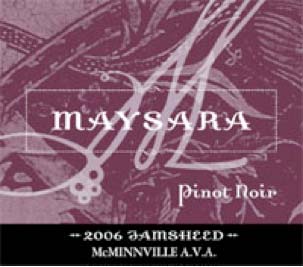 2007 Maysara Jamsheed McMinnville Pinot Noir $25. According to Persian legend, King Jamsheed was able to observe his entire realm by peering into his full wine goblet. This is a fitting name for a wine that is a blend from every block of four to 10 year old vines in the estate vineyard including Pommard and Dijon clones. A combination of free run and press wine, 24% whole cluster fermentation, native yeast fermentation, aged in 8% new French oak. Unfined and unfiltered. · A lighter-styled Pinot showing aromas and flavors of dark plums, blackberries and cassis. Appealing spice compliments the fruit and lively acidity provides a refreshing finish. A good daily drinker.
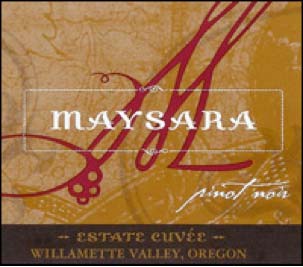 2006 Maysara Estate Cuvée McMinnville Pinot Noir $32. Multiple Dijon clones with some Pommard predominately 9-year old vines. 90% de-stemmed, two week native fermentation, all free run juice, aged in 40% new French oak. · A very young wine that will benefit from more bottle age. Lovely cherries, raspberries, pomegranates and spice elegantly presented with fine-grained tannins and respectable acidity.
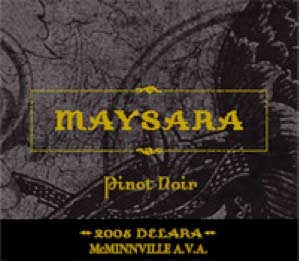 2005 Maysara Delara McMinnville Pinot Noir $50. Delara is a Persian word that translates as “capture one’s heart.” Represents the entire clonal selection of the Momtazi Vineyard (more than half is Pommard and Dijon 115). 80% de-stemmed, 2-3 week native fermentation, free run wine aged in 30% new French oak, racked once off its lees in 13 months and then bottled. Unfined and unfiltered. · A darker, more structured wine with great fruit intensity. A panoply of berry aromas accented by a hint of spearmint and roseate scents. Richly layered with jammy dark fruits and mouth coating tannins. From an age-worthy vintage, this wine will benefit from decanting or another few years in the cellar.
I also tasted the 2007 Maysara Pinot Blanc (24 cases, sold out) and it was one of the best examples I have ever had from Oregon.
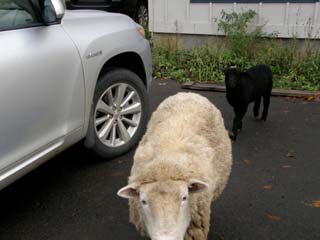 Maysara Winery is open for tasting every Monday through Saturday from 12:00 to 5:00. Try to call ahead and plan a tour of this marvelous property when you go. You will find it extremely inspiring. When I visited, Moe was directing a crew in the building of a large storage structure on the property. The timber had been sourced from the property, was being milled on site and assembled into supports for the roof. The tasting room wood flooring was sourced from the property as well. If you are lucky, you will have the same reception as I did when I arrived (see photo, right). The Momtazi Vineyard and Maysara Winery is located at 15765 SW Muddy Valley Road in McMinnville. 503-843-1234. The website is www.maysara.com.
Ribbon RidgeAppellation Approved: 2005 History: Harry Peterson-Nedry was the first to plant grapes in the appellation at Ridgecrest Vineyards in 1980. Geography: See comments under Chehalem Mountains. Ribbon Ridge is located 4 miles northeast of Dundee between the towns of Newberg and Gaston at the northwest end of the Chehalem Mountains. Ribbon Ridge is contained wholly within the Chehalem Mountains appellation. Configured in a somewhat uniform bread loaf like shape, it represents an island-like spur of ocean sediment uplift. This small appellation is protected by geographic land masses on the north, south and west sides. The appellation’s elevation minimum is 200 feet and maximum is 683 feet. Size: 3,350 acres Vineyards: 500 acres, 20 vineyards Wineries: 5 Soils: Primarily ocean sedimentary sandstone that is younger and more uniform than the soils of neighboring regions. Moderately deep, well-drained Willakenzie soil series. Climate: The protected location creates a moderate climate. The few aquifers requires many vineyards to be dry farmed. Flavor Profile of Pinot Noirs: Bright red cherry that can be pushed to black fruit (black cherry, blackberry and black currant), brown and wood spices, cola, anise, wet leaf, loamy earthy and chocolate. Usually fine tannins and well structured, but the winemaker’s hand may influence the tannins and character of the fruit. The acidity is usually good, especially in higher elevations and the wines age well as a result. Prominent Producers in the Appellation: Ayres Vineyard, Beaux Freres, Brick House Vineyards, Patricia Green Cellars, Redman Wines, Ribbon Ridge Vineyard, RR (Ridgecrest Vineyard), and Styring Vineyards. Appellation Website: www.ribbonridge.org (Listed by the Willamette Valley Winegrowers Association but the site is not functional at present.)
Yamhill-Carlton DistrictAppellation Approved: 2005 History: In 1974, Pat and Joe Campbell started Elk Cove Vineyards and produced the first commercial wine from this region. Geography: The Yamhill-Carlton District is formed by the foothills of the Coastal Range, is located north of McMinnville and incorporates the towns of Carlton and Yamhill. The elevation contour is 200 to 1,000 feet above sea level. The North Yamhill River flows through the center of the appellation. Size: 60,000 acres Vineyards: 1,200 acres, 60 vineyards Wineries: 20 Soils: Ancient marine sedimentary soils over sandstone and siltstone (Willakenzie series). The soils drain quickly creating a natural deficit-irrigation effect so that vines stop vegetative growth earlier here than elsewhere, leading to complete ripening, even in cooler growing seasons. The soils are the oldest in the Willamette Valley. Climate: Protected by the Coastal Range Mountains to the west, the Chehalem Mountains to the north, and the Dundee hills to the east. There is still marine influence with more rain and wind than the Dundee Hills to the east. Average rainfall is 60 inches annually. The diagram from the Yamhill-Carlton District website shows the wind and weather patterns in the northern Willamette Valley.
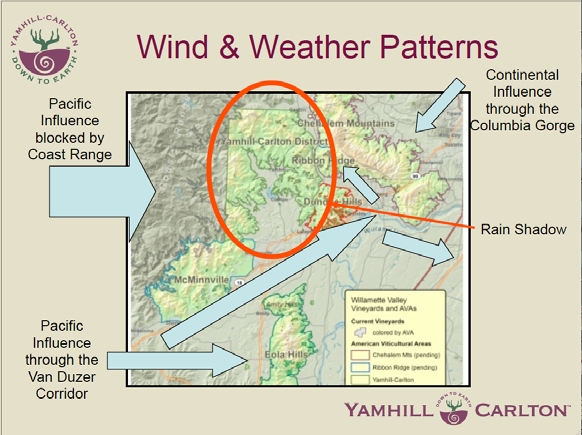 Flavor Profile of Pinot Noirs: Black cherry, blackberry, black raspberry, black currant, blueberry, anise, clove, violet, lavender, pipe tobacco, wood smoke, chocolate, earthiness, and mushroom. Untamed, wild and brooding fruit. Lower acid than grapes grown on basaltic or loess soils. Broad, silky and rustic tannins. Prominent Producers in the Appellation: Anne Amie Vineyards, Belle Pente Wine Cellars, Domaine Meriwether, Elk Cove Vineyards, Hamacher Wines, Kramer Vineyards, Lemelson Vineyard, Monks Gate Vineyard, Penner-Ash Wine Cellars, Retour Wines, Scott Paul, Shea Wine Cellars, Solena Cellars, Stag Hollow Wines & Vineyard, Thistle Wines, Twelve, and Willakenzie Estate Winery.
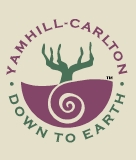
The Four Graces is a newer producer of Pinot Noir whose inaugural vintage was 2003. Named for the four daughters of proprietors Steve and Paula Black, the wines are sourced from the family’s 54-acre Black Family Estate Vineyard in the Dundee Hills appellation. A second vineyard, Doe Ridge Estate, is of particular interest. Located in the Yamhill-Carlton District appellation, this 90-acre site was bought and planted in 2005 and saw its first harvest this year. This is a very unique project. It consists of two 20-acre parcels divided by a natural habitat ravine containing a stream, with both parcels having very similar soils and exposure. The two parcels were planted at the same time to the same clones on identical rootstocks. One parcel is farmed biodynamically and the other one is farmed according to LIVE guidelines. As the vines mature, it will be very interesting to compare the Pinot Noirs that originate from the two highly similar, but differently farmed parcels of the same vineyard. Noted winegrower Laurent Montalieu (Willakenzie, Solena) and French consultant Phillippe Armenier are directing the biodynamic program and viticulturalist Luke Pedotti supervised the planting and management of the vineyards. Dijon clones 115, 667 and 77 and Pommard are grafted to divigorating rootstocks, 101-14 and Riparia Gloire, and are planted at 2555 vines per acre (1.9 m x 1.0 m spacing). An interview with both Laurent Montalieu and Luke Pedotti will be presented in a future Grape Radio podcast. I tasted briefly barrel samples of 2008 Doe Ridge Estate Pinot Noir from the two parcels and there were definite differences noted. The wines are too young to make any definitive characterizations.
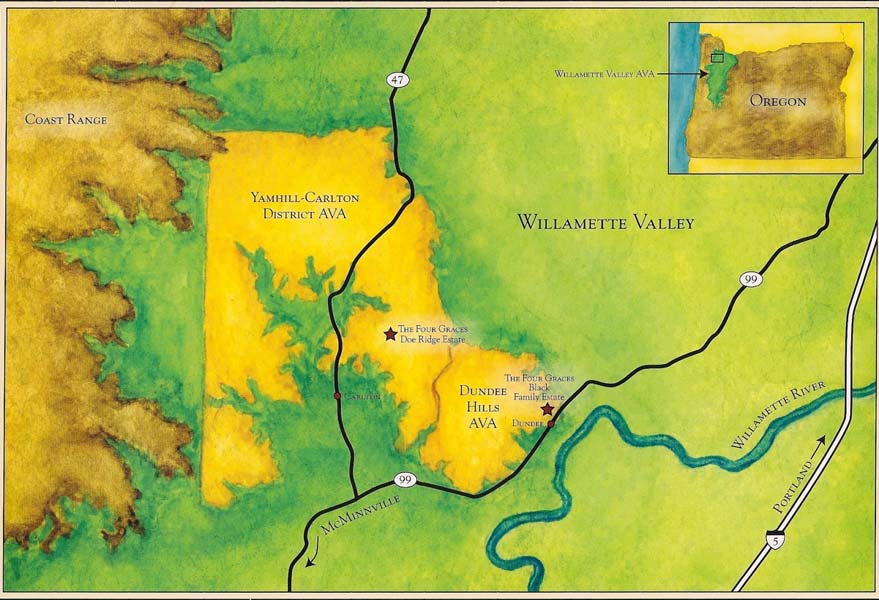
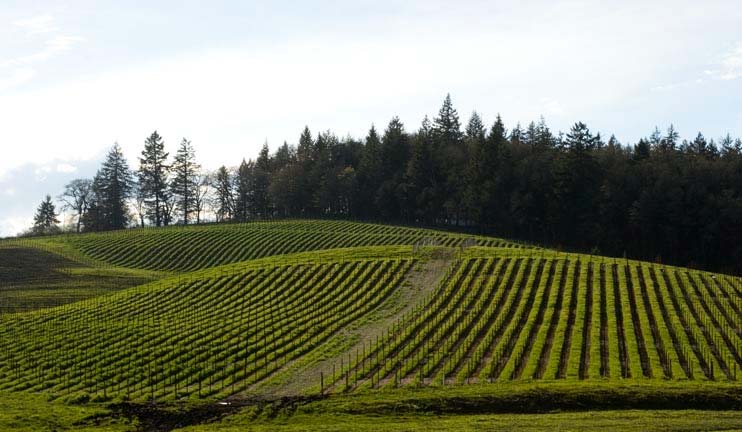 The Four Graces has a tasteful tasting room with outdoor seating among the neighboring vineyard on Highway 99W in Dundee. The address is 9605 NE Fox Farm Road. The tasting room is open daily from 10:00 to 5:00. 503-554-0632. Visit the website at www.thefourgraces.com.
Tasting the Six Appellations with Grape RadioGrape Radio hosts Jay Selman and Eric Anderson joined me recently to taste 2006 Willamette Valley Pinot Noirs representing each of the six sub-appellations (there was one 2005 vintage wine). I am trying to educate Jay about Pinot Noir and it is a long, arduous and thankless task. The convivial banter can be heard on an upcoming Grape Radio podcast. Chehalem Mountains
2006 ArborBrook Vineyards Estate 777 Block Chehalem Mountains Pinot Noir 13.7% alc., $30. · Plenty of oak and herbs on the nose with a hint of alcohol. Prolific earth-kissed black cherry and plummy fruit with mild tannins and zingy acidity. Lacks complexity.
2006 Laura Volkman Vineyards Jacob Estate Chehalem Mountains Pinot Noir 14.4% alc., $42. · A highly perfumed nose of dark cherry and berry fruits with a toast and coffee accent. Earthy black cherry with a seamless texture and supple tannins. I have tasted this wine on multiple occasions and it never fails to make the hair on my neck stand erect.
Dundee Hills
2006 Et Fille Maresh Vineyard Dundee Hills Pinot Noir 13.6% alc., $42. · Noticeably redder and lighter in color. Shy aromas of herbed red fruits with a petrol note. Light and elegant on the palate, the red cherry, red currant and pomegranate flavors are enhanced by a luscious spiciness most noticeably nutmeg.
2006 Domaine Drouhin Dundee Hills Pinot Noir 14.1% alc., $39. · An immensely satisfying and highcollared red cherry and berry melange, smoothly textured and displaying a welcome mineral and aciddriven liveliness and refined tannins. I have found several tasters who prefer more intense and hedonistic fruit to be disappointed in this wine but I find it remarkably pinotypical.
Eola-Amity Hills
2006 Torii Mor Eola Amity Hills Select Pinot Noir 14.25% alc., $50. · Brimming with a complex bouquet of blue and purple fruits, roasted nuts, oak spice and a touch of tobacco. The black cherry core saturates the midpalate. The wine is very smoothly textured with enough lively acidity to satiate the thirst.
2006 Cristom Eileen Vineyard Eola-Amity Hills Pinot Noir 14.5% alc., $24 (1/2 bottle). · A spicy, cherry driven wine that is alive with scent and flat out delicious. Very harmonious with faint oak influence, supple ripe tannins and a gentle texture. The best wine of many great wines in this lineup today.
McMinnville
2006 Brittan Vineyards Basalt Block McMinnville Pinot Noir 14.6% alc., $45. · This wine keeps opening and opening in the glass. Sumptuous blackberry, cranberry and pomegranate fruit with an earthy bent. Attractive nose endowed with minerality, forest floor and a touch of alcohol. Smooth and supple tannins.
2006 Raptor Ridge Meredith Mitchell Vineyard McMinnville Pinot Noir 15.5% alc., 192 cases, $35. · A plush palate of dark berries, earth, meat, and game with a barely noticeable nerve of acidity. Admirable integration of oak and alcohol. Substantial tannins may require more time to meld.
Ribbon Ridge
2006 Patricia Green Cellars Estate Ribbon Ridge Pinot Noir 13.5% alc., $33. · A good wine alive with the scents of red cherries, violets, and new-sawn oak. On the palate the soft cherries are nicely herbed and a refreshing citric tang completes the finish.
2005 Beaux Freres The Beaux Freres Vineyard Ribbon Ridge Pinot Noir 13.7% alc., $75. · The most expensive, yet the group’s least preferred wine in the lineup. Attractive aromas of dark red fruits, rose petals and root beer. Deep red raspberries and currants are well-oaked, tannins are substantial, and there is good persistence on the citric peel themed finish.
Yamhill-Carlton District
2006 Soter Beacon Hill Yamhill-Carlton District Pinot Noir 13.8% alc., $50. · An interesting nose with scents of Mexican spices, cumin, spearmint and red and blue fruits. Solid black cherry core with notable minerality, mild dry tannins and an elegant presence. Well-crafted but not extraordinary for me.
2006 Resonance Vineyard Yamhill-Carlton District Pinot Noir 13.8% alc., $50. · Rich dark red raspberry liquor that is floral and perfumed. Bright and fresh fruit with a touch of mocha, long and smooth in the mouth, lively acidity and very supple tannins.
Every taster had their favorites but the fact remains that Oregon is producing regal Pinot Noirs with plenty of welcoming balance, length and acidity. Could we match these wines to their respective sub-appellations if tasted blind? No way, except maybe the Dundee Hills Pinot Noirs. Nevertheless, it is a commendable geeky pastime to talk about Pinot Noir characteristics from the different sub-appellations.
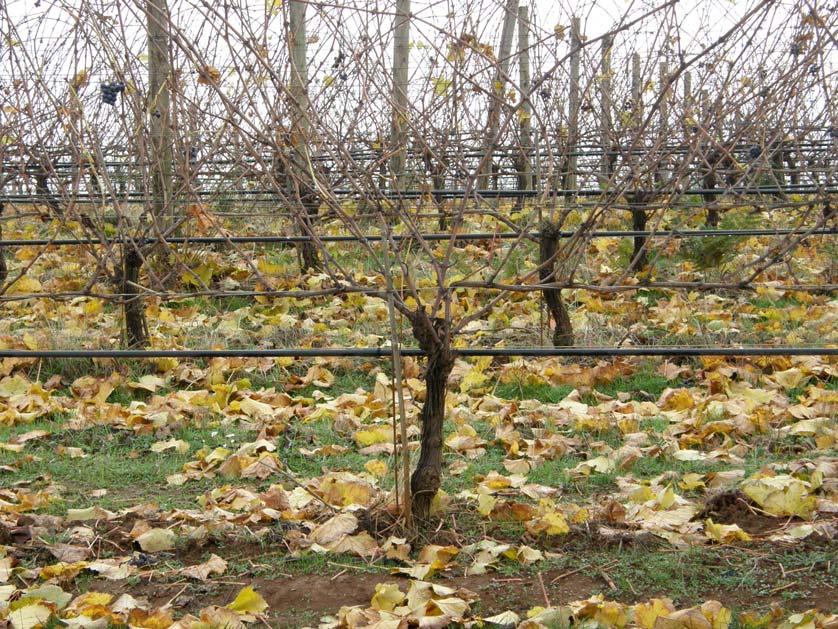
SummarySince some sub-appellations have one predominant soil type and others have two or three different types, there is not a direct correlation between specific soil types and the six sub-appellations of the Willamette Valley. Geographic and climatic factors are as important as soil type in defining the unique characteristics of each appellation. Chehalem Mountains AVA: basaltic (Jory) and marine sedimentary (Willakenzie) on the southern western slopes; ice-age loess on the northeastern slope Dundee Hills AVA: mostly basaltic (Jory) but marine sedimentary (Willakenzie) at the lower elevations on the western and northern slopes Eola-Amity Hills AVA: mostly basaltic (Jory) but marine sedimentary (Willakenzie) at the lower elevations on the western and northern slopes McMinnville AVA: primarily marine sedimentary (Willakenzie) with some basalt (Jory) and alluvium Ribbon Ridge AVA: entirely marine sedimentary (Willakenzie) Yamhill-Carlton AVA: marine sedimentary predominant (Willakenzie) Each of the sub-appellations’ Pinot Noirs exhibit a flavor profile which is related to soil type, geography and climate as well as viticulture and the winemaker’s hand. The multiplicity of variables make strict and dogmatic flavor profile definitions of each sub-appellation impractical, but generalizations can be highly useful in characterizing the wines from each sub-appellation.
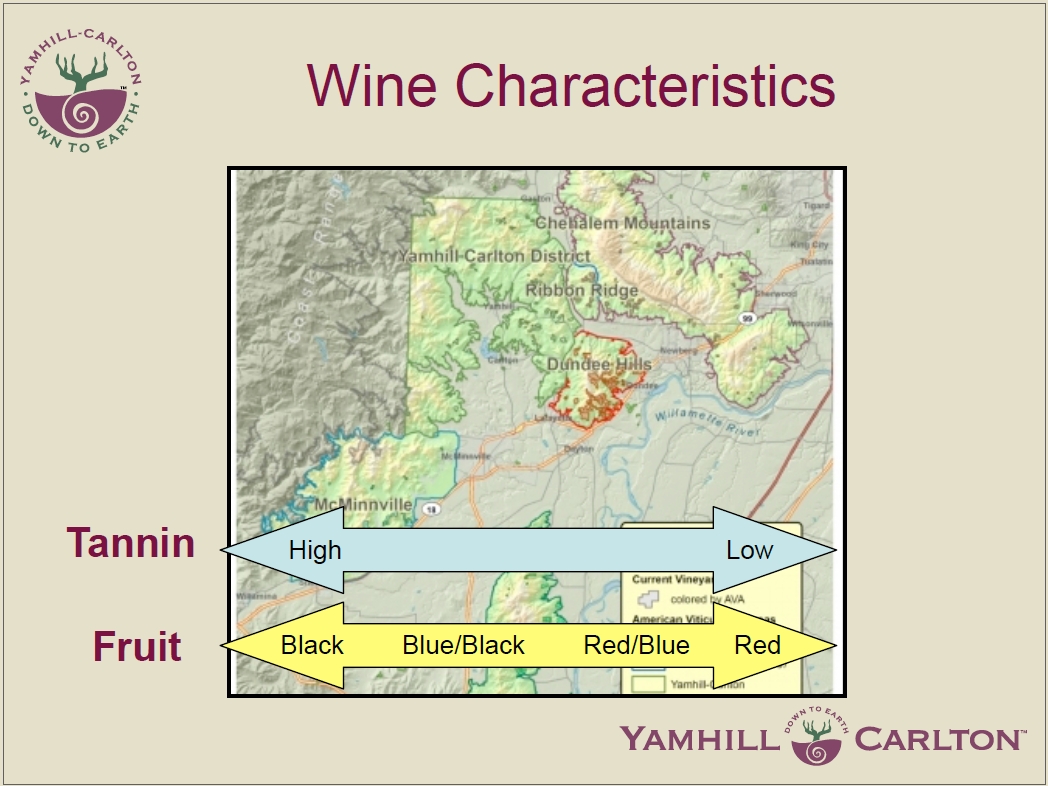
Passion for Pinot
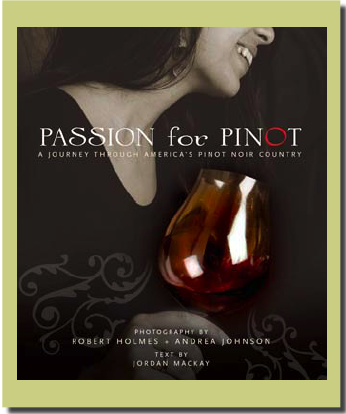 Photographers Robert Holmes and Andrea Johnson along with writer Jordan Mackay have accomplished the masterful task of creating a book that captures the spirit of Pinot Noir. To satiate my own passion for Pinot Noir, I had envisioned doing a similar project for several years but never found the time. Imagine how thrilled I was, then, to discover this beautiful book with breath taking photography of American Pinot Noir winegrowing regions and wine people. The hardcover book is more than a fancy picture book to put out on your coffee table and forget about. It is filled with pinotspeak and valuable information about the one grape that is uniquely capable of creating an almost religious passion among its devotees. Andrea Johnson is a well-known freelance photographer specializing in wine and travel with many of her pictures featured regularly in prestigious publications. Robert Holmes is a renowned photographer and writer who has illustrated more than forty books, has worked for many of the world’s major magazines and twice was named “Travel Photographer of the Year” by the Society of American Travel Writers. Jordan Mackay has been a contributing writer for Wine & Spirits, Food and Wine, Gourmet, and Wine Enthusiast. Following a foreword by noted wine writer, Eric Asimov, the contents weave a journey through the vineyards and wineries of America, stopping along the way to capture the essence of Pinot Noir. Chapters include: A Perfect Storm of Pinot, Terroir, A Year in the Vineyard, From Grape to Wine, and In the Glass. For a peak of the book and some of its pages, visit www.pinotbook.com. The book is currently available at multiple wineries in California and Oregon listed on the pinotbook website and the authors are traveling to wineries for book signing events. Passion for Pinot will be available nationwide at bookstores in March of 2009 and is available now for pre-order at the published price of $30.
I spoke with Andrea and Robert at this year’s ¡Salud! Oregon Wine Auction where the book had its coronation.
To listen to the recording.....“Passion for Pinot Photographers Interview” |